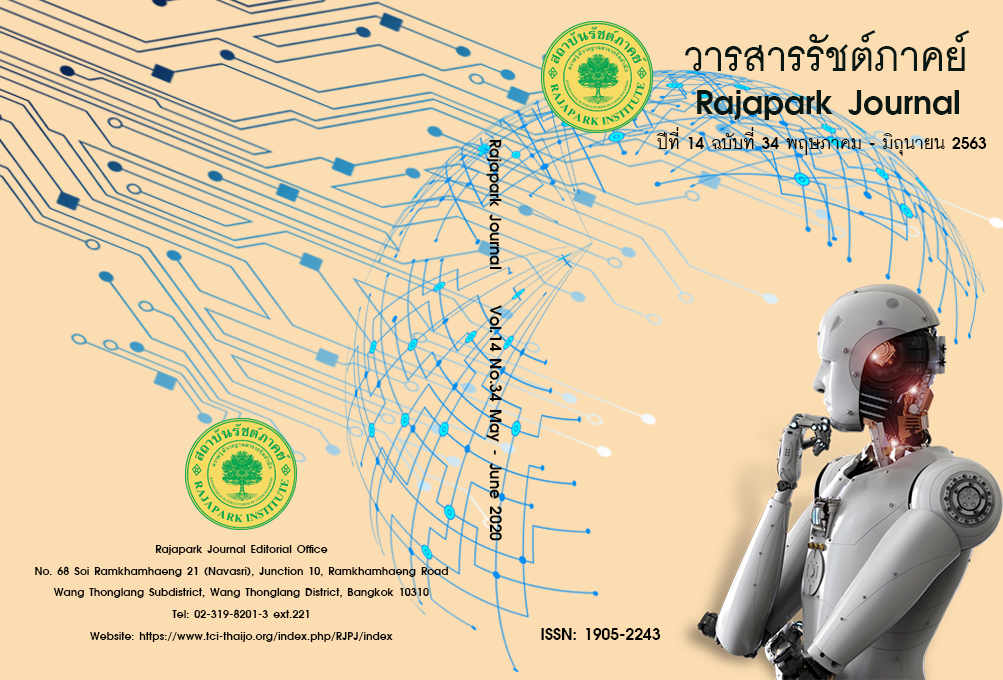The Potentiality Development of Community-Based Tourism in Nakhon Ratchasima Province
Main Article Content
Abstract
This research aimed to study the potentiality level of community-based tourism through the analysis of tourist’s feedback separating by demographic and tourist behavior. It is the quantitative research using the survey with Cronbach’s alpha 0.97 for data collection. The sampling target is the tourist group that traveled to the destinations where are community-based tourism in Nakhon Ratchasima Province. There are 420 data subjects following the calculation of William G. Cochran with the purposive sampling method used as the input of this research. The analysis methods are descriptive statistics, a t-test statistic, and an F-test statistic. The interpretation of research results on a potentiality level of community-based tourism in Nakhon Ratchasima province is at a medium level. For the mean comparison of tourist’s feedbacks in potentiality on a demographic domain, the tourist group with different gender, age, education level, occupation, marital status, and salary provided the different feedback on the potentiality level of community-based tourism in Nakhon Ratchasima province significantly differently at 0.05. On the comparison of tourist feedback comparing on tourist’s behavior domain found that the tourism group with a different number of companion, traveling time/season, frequency of traveling and budget for traveling shared the different feedback on the potentiality level of community-based tourism in Nakhon Ratchasima province significantly differently at 0.05. The tourist group who has different traveling objectives and transportations shared the same feedback on the potentiality level of community-based tourism in Nakhon Ratchasima Province.
Article Details
Views and opinions appearing in the Journal it is the responsibility of the author of the article, and does not constitute the view and responsibility of the editorial team.
References
Boonyapak, W. (2007). Thai Tourism Resources. Nonthaburi: School of Management Science,
Sukhothai Thammathirat Open University.
Bloom, B. S. (1976). Human characteristics and school learning. New York, NY, US: McGraw-Hill.
Chatchakun, N. (2014). Tourism Industry (5th ed.). Bangkok: Chulalongkorn University Press.
Choibamroong, T. (2008). Andaman Cultural Tourism: The Change of Anadaman to Sustainability.
Bangkok: The Thailand Research Fund (TRF).
Cochran, William G. (1977). Sampling Tech niques (3rd ed.). USA: John Wiley & Sons, Inc.
Esichaikul, R., & Songsoonthornwong, C. (2009). Tourism Promotion for Senior Tourists from
Europe to Thailand. Retrieved from http://ird.stou.ac.th/dbresearch/fDetail.php?fID=6
Goodwin, H. & Santilli, R. (2009). Community-Based Tourism: a success? ICRT Occasional Paper,
, 1-37.
Loylertritt, P., & Taweepho, R. (2560). The appraisal component of cultural tourism for senior
citizen in Petchburi at Mrigadayavan palace. The Creative RMUT and Sustainable
Innovation for Thailand 4.0, 1452-1459.
Nakhon Ratchasima Chamber of Commerce. (2018). Korat Tourism Cluster [Press release].
Retrieved from http://www.ncc.or.th
Nakhon Ratchasima Province. (2018). Nakhon Ratchasima development 4 years plan (2018-2021).
Retrieved from http://www.nakhonratchasima.go.th.strategy/strg_plan61_64_section
_3.pdf.
Nathongkaew, B., Ruksapol, A., Phengkona, J., & Jittapraphan, B. (2017). Potential and Guidelines
for Tourism Development in Khanthuli Sub-district, Suratthani Province. Area Based Development Research Journal, 9(2), 106-121.
Phoomivuthisarn, N. (2000). Promotion management (2nd ed). Bangkok: Chulalongkorn University.
Provincial Community Development Office of Nakhon Ratchasima. (2018). Government letter in the
meeting of district community experts (9/2018). Nakhon Ratchasima: Provincial Community Development Office of Nakhon Ratchasima. Retrieved from http://korat.cdd.go.th/2018/09/28/ประชุมพัฒนาการอำเภอ3.
Rocharungsat, P. (2010). Community-based tourism. Bangkok: Oseon Store.
Saewong, J. (2013). Consumer Behavior. Songkhla: Faculty of Management Sciences, Songkhla
Rajabhat University.
Serirat, S. (1995). Consumer Behavior. Bangkok: Thai Watana Panich.
Singsaktrakul, P., & Sermkarndee, P. (2013). The Study of Potentiality and Conservation Tourism
Development Approach of Baan Thung-Maprang, Kuan Doan District and Baan Ton-Panan, Kuan Kalong District in Satun Province. Suddhiparitad, 27(83), 97-112.
Thaiked, P. (2017). The potentiality development guideline for community-based tourism of
Wiang-sa Surat Thani province. Retrieved from http://tour.nida.ac.th/wp-content/ uploads/2017/05/wiang-sa.pdf
The Association of Southeast Asian Nations (ASEAN). (2016). ASEAN Community Based Tourism
Standard, T. A. o. S. A. N. (ASEAN) (Ed.), 270.
The Thailand Community Based Tourism Institute. (2018). Community – Based Tourism. Retrieved
Tourism Authority of Thailand (TAT). (2018). Amazing Thailand Go Local. TAT Review, 4, 14.
Tourism Authority of Thailand. (2018a). Tourism Go local: Amazing Thailand Go Local. TAT Review,
Tourism Authority of Thailand. (2018b). Tourism Authority of Thailand Operational Plan 2018.
Bangkok: Tourism Authority of Thailand, Retrieved from https://www.tourismthailand.org/
fileadmin/downloads/pdf/ 2561.pdf.


